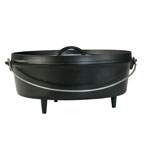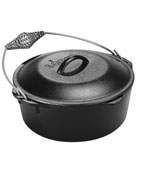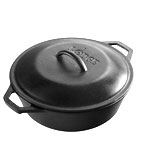When I started looking at dutch ovens this year, I had no idea there were so many different kinds. Flat bottoms, bottoms with legs, bail handles, and lids that double as frying pans – there was certainly more to these aluminum or cast iron pots than I expected.
Dutch ovens are the original crockpots. Like a crockpot, you can throw just about anything in a dutch oven and it will come out tasting great. For camping, a dutch oven can be used for all three meals. In fact, we’re looking forward to breaking ours in with one of our kid’s favorite breakfast treats: German Pancakes. I’m expecting them to taste even better in the backcountry than they do at home!
Camp Dutch Oven
 Camp dutch ovens are easily distinguished by their stubby legs and flat lids with a raised flange around the edge. The legs allow air circulation underneath the camp dutch oven, when it is sitting in coals. The raised flange around the edge of the lid keeps coals from sliding off.
Camp dutch ovens are easily distinguished by their stubby legs and flat lids with a raised flange around the edge. The legs allow air circulation underneath the camp dutch oven, when it is sitting in coals. The raised flange around the edge of the lid keeps coals from sliding off.
Traditional Dutch Oven
 A traditional dutch oven has a flat bottom with a domed basting lid. With their flat bottoms, traditional dutch ovens are made more for stove tops and campfire grates, then for sitting on coals.
A traditional dutch oven has a flat bottom with a domed basting lid. With their flat bottoms, traditional dutch ovens are made more for stove tops and campfire grates, then for sitting on coals.
There are many variations on these two themes. Not all dutch ovens have wire bail handles, but if you are interested in tripod cooking over an open fire, this will be an essential feature to look for.
 The dutch oven that we selected (for you, too – we’re giving away two of these in April!) is a variation on the traditional theme. It has loop handles which make it easier to carry than a wire bail. You have to remember that these are a bit heavier than your kitchen pots and pans – this one tips the scales at close to 20lbs.
The dutch oven that we selected (for you, too – we’re giving away two of these in April!) is a variation on the traditional theme. It has loop handles which make it easier to carry than a wire bail. You have to remember that these are a bit heavier than your kitchen pots and pans – this one tips the scales at close to 20lbs.
All of our cooking is on camp stoves or wood fires, so a traditional smooth-bottomed dutch oven made more sense for us. Because we use a camps stove, the size of the dutch oven was also an important consideration. Too wide, and there isn’t enough room left on the stove for another pot, or frying pan and, suddenly, the two-burner camp stove is effectively a single-burner. We selected a 5qt. model that is 10 ¼ inches wide.
We are looking forward to putting our new dutch oven to good use and hope to share some of our favorite recipes with you. Stay tuned!
See also…

Hi,
i came across your website. and i love the topics since i am dutch oven lover. This is used for many years. It has been a high quality materials that we can trusted.
Thanks,
Dutch Oven Easy
Pingback: Different Kinds of Dutch Ovens | BoyandGirlScouts.com - News, Opinion, Advice
I went out and got a new 12″ lodge dutch oven today and can’t wait to try it out.
That’s good to know, Pietschoice, I just washed mine up last night and gave it a light coat of oil – can’t wait to try it out!
We have been RVers for many years and much of our outdoor cooking is done in Lodge Dutch Ovens. I can’t say enough about the great results we get each time we use them.
Pingback: Topics about Camping » Archive » Dutch Oven Buyer’s Guide
in-a-tent the ones pictured are from Lodge (http://www.lodgemfg.com/) here in the states. I might be wrong, but I thiink Le Creuset’s products are all enameled? That is my problem with our current pots and pans (that are just old ones from the house), they are all coated with non-stick material that does not hold up well to camp cooking. I’m looking forward to reading your blog! I just discovered it this morning via Twitter.
These look at lot like Le Creuset cast iron cookware is that right or are they fundamentally different from those?
Le Creuset are expensive but pretty indestructible. (I’m in the UK hence my confusion with US terminology)
in-a-tent’s last blog post..Therm-a-Rest versus Airic